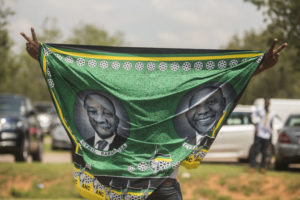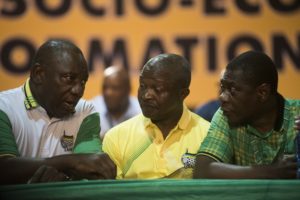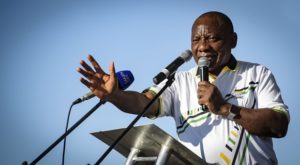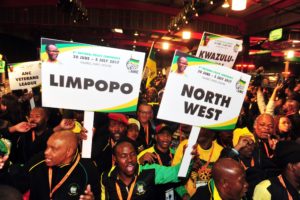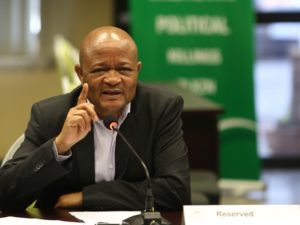Adriaan Basson: 3 things Cyril needs to do to win

JOHANNESBURG, SOUTH AFRICA – OCTOBER 07: Deputy President Cyril Ramaphosa at the ANCYL 73rd birthday celebrations at Hillbrow Theatre on October 07, 2017 in Johannesburg, South Africa. During his address, Ramaphosa encouraged the election of young people into the national executive committee of the ANC. (Photo by Gallo Images / Rapport / Elizabeth Sejake)
The ANC’s branch nominations are in and deputy president Cyril Ramaphosa is in front.
The “buffalo soldier” scored 1860 branch nominations against Nkosazana Dlamini-Zuma’s 1330.
But that’s only half of the story and Team Ramaphosa won’t be sipping French champagne – yet.
Branches don’t vote at the national conference; delegates do. The size of a branch determines the number of delegates from that branch. For example, an ANC branch from Durban may have six delegates at conference whereas the Izingolweni branch may only have one.
Those differences aren’t visible in this round’s nominations.
The closest one can get to convert branch nominations into delegate numbers at this stage, is by using the percentages scored in each of the provinces by both candidates and extrapolate that to the delegate numbers.
Even that will have errors; not all branches have declared their results, and some have been disqualified. Brace yourself for bruising legal challenges before and after conference to challenge the results.
In some provinces, other presidential candidates like Zweli Mkhize received a very small percentage of votes.
To extrapolate is definitely not scientific, but it’s the closest indicator of what the ultimate result may be when the ANC elects a new president in ten days’ time. The Rampahosa camp has done a similar exercise and the table below is based on theirs, with some changes.
| Province | Branch nominations | Total branches | Delegates | Extrapolated delegates | ||
|---|---|---|---|---|---|---|
| CR | NDZ | CR | NDZ | |||
| KwaZulu-Natal | 191 | 454 | 806 | 870 | 258 | 612 |
| Mpumalanga | 117 | 346 | 491 | 736 | 185 | 551 |
| Eastern Cape | 423 | 61 | 601 | 648 | 566 | 82 |
| Limpopo | 391 | 104 | 515 | 643 | 508 | 135 |
| North West | 45 | 291 | 353 | 538 | 72 | 466 |
| Gauteng | 374 | 64 | 476 | 508 | 434 | 74 |
| Free State | 44 | 209 | 297 | 409 | 71 | 338 |
| Northern Cape | 154 | 11 | 181 | 197 | 184 | 13 |
| Western Cape | 121 | 13 | 160 | 182 | 164 | 18 |
| 1860 | 1553 | 3880 | 4731 | 2442 | 2289 | |
| ANCWL | 0 | 60 | ||||
| ANCYL | 0 | 60 | ||||
| ANCVL | 60 | 0 | ||||
| PEC | 135 | 108 | ||||
| NEC | 46 | 40 | ||||
| 241 | 268 | |||||
| Total | 2683 | 2557 | ||||
A number of things are clear from this.
* The final tally will probably be much closer than the result of the branch nominations. As little as 100 to 200 votes can swing things either way.
* According to declared branch nominations, Ramaphosa scored almost 30% of nominations from KwaZulu-Natal. That is an incredible victory for him and his provincial campaigners, chiefly former premier Senzo Mchunu and former police chief Bheki Cele. But there are two big caveats: Only 645 out of the province’s 806 branches have declared, meaning 161 nominations are outstanding that could change the picture dramatically. Secondly, it is unclear what the size of the branches are that endorsed Ramaphosa. It is possible that Dlamini-Zuma can score most of the large branches, which will increase her percentage votes from the province.
* I’ve added the 223 “Unity” votes from Mpumalanga to Dlamini-Zuma’s total in that province, after strong indications by premier David Mabuza (who is the frontrunner for deputy presidency) that he would negotiate with her if the unity project fails. What’s interesting from this extrapolation is the Ramaphosa could technically still win, even if Mabuza throws in his “unity” lot with Dlamini-Zuma and Ramaphosa’s support remains static. But this will require Ramaphosa to carry the 30% support from KwaZulu-Natal branches through to delegates and his percentage support from other provinces to translate into delegates’ votes.
* The votes of the leagues and provincial and national executive committees are expected to be almost halved between the candidates. Although the race will be close, they are unlikely to be able to swing the final result either way.
As has been said by many a commentator, the battle for votes will now move to individual delegates, who can vote for who they want to at conference. This is also high-alert for vote-buying, particularly in those provinces where lobbyists think they can claw back support.
What are the three things Ramaphosa absolutely needs to do to win at Nasrec?
1. He and his supporters must consolidate his 30% support in KwaZulu-Natal. This result is a major setback for Dlamini-Zuma and the so-called premier league and she and her team, including premier Sihle Zikalala, will aggressively campaign to recoup some of the losses in the province.
2. Ramaphosa must lobby hard to win over some of the “unity” voters in Mpumalanga. Although he is a strongman-premier, there have been suggestions that Mabuza may not have complete sway over his delegates. This was clear when 240 branches broke ranks and either nominated Ramaphosa or Dlamini-Zuma for president, and not “unity” as Mabuza wanted them to. Still, the size of Mpumalanga’s delegation means any inroads into the “unity” votes will be substantial and Mabuza remains the kingmaker.
3. Team Ramaphosa will have to be extremely vigilant at attempts to remove his supporters from provincial delegations or attempts to bribe them to change their votes. Particularly in KwaZulu-Natal and Mpumalanga, Ramaphosa will have to raise alarm at attempts to subvert the will of the branches.
What does this mean for Dlamini-Zuma? She simply has to claw back support in KwaZulu-Natal and convince kingmaker Mabuza to go with her to win.
It’s down to the wire.
– Basson is editor-in-chief of News24. Follow him on Twitter: @AdriaanBasson
(Photo credit: Gallo Images / Rapport / Elizabeth Sejake)
